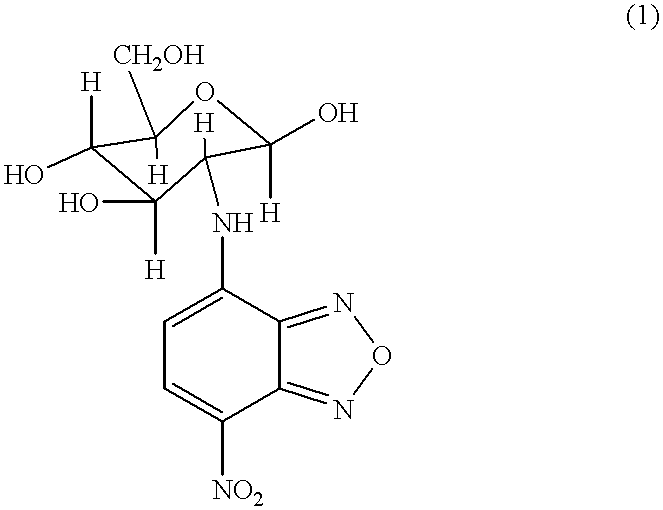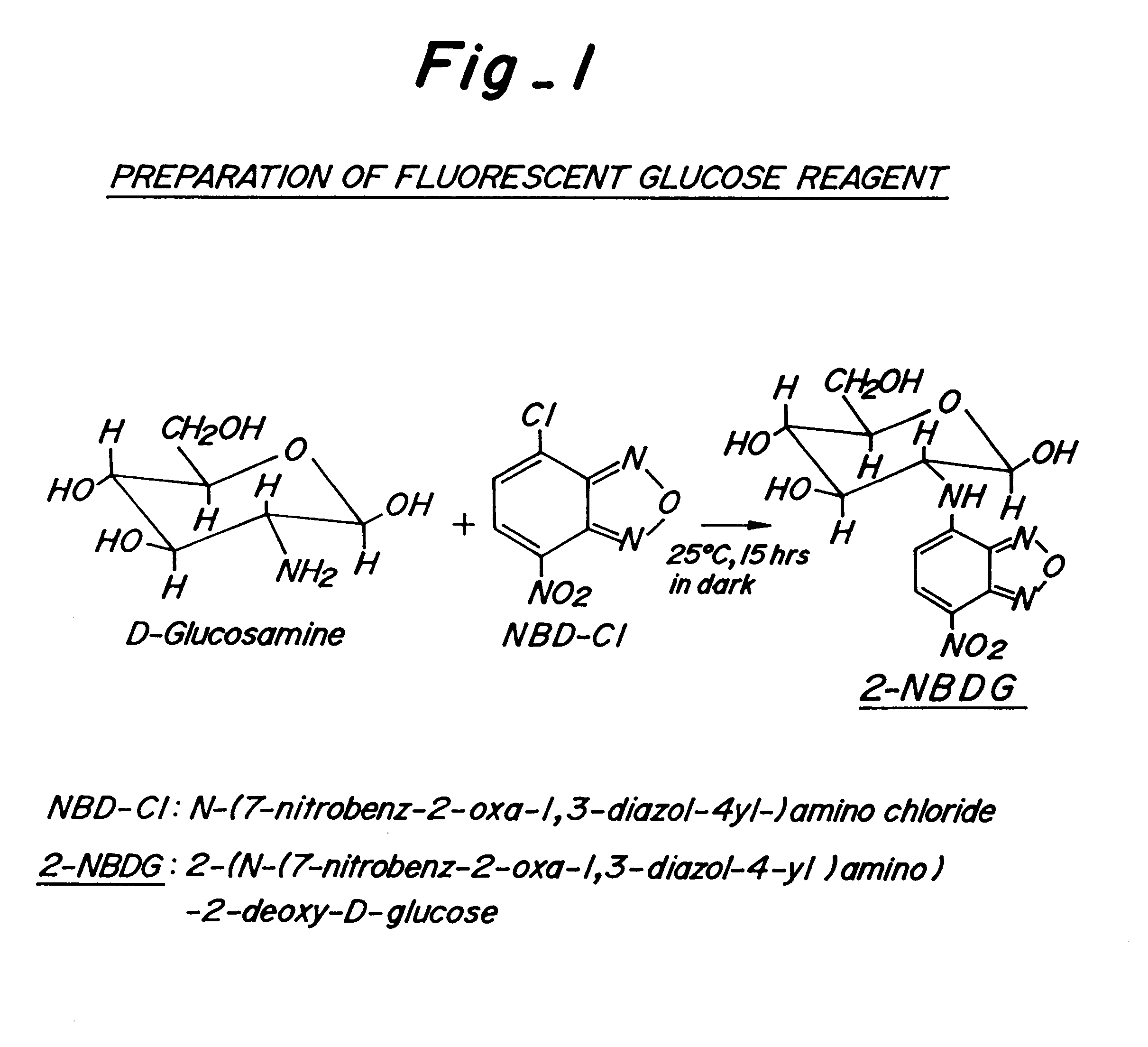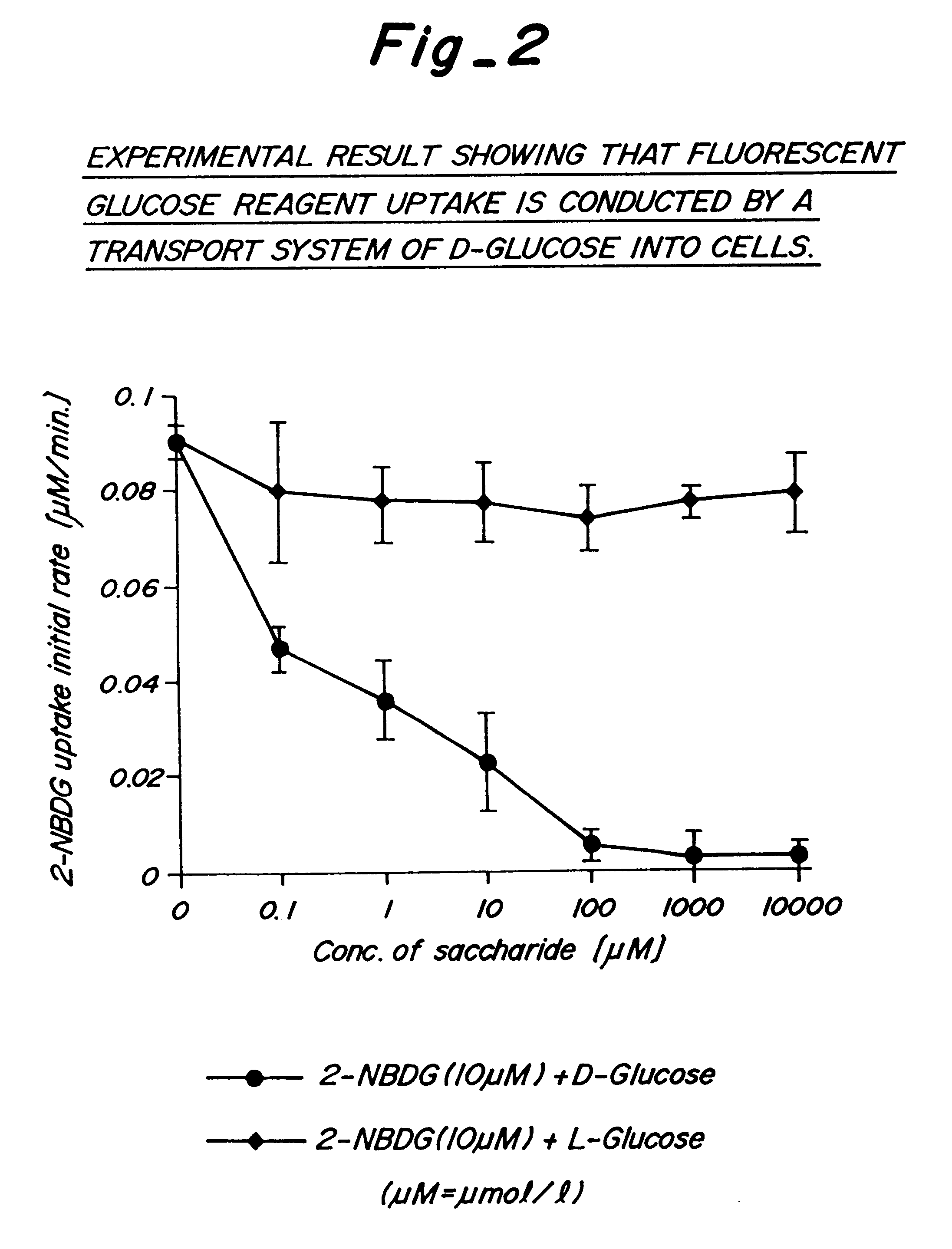Fluorescent imaging method of saccharide uptake activity of living tissue
a living tissue and fluorescence imaging technology, applied in the field of biochemistry, can solve the problems of insufficient spatial resolution, inability to allow, and no useful imaging methods for glucose uptake activity have been developed until now
- Summary
- Abstract
- Description
- Claims
- Application Information
AI Technical Summary
Problems solved by technology
Method used
Image
Examples
example 1
It was confirmed with cells of coliform bacillus, E. coli, and a yeast that the 2-NBDG (molecular weight: 342), which was a glucose derivative (molecular weight: 180) having at its C-2 position a side chain of molecular weight of at most 300, was incorporated equivalently to glucose. The graph shown in FIG. 2 is a result of the coliform bacillus. Namely, coliform bacilli (E. coli) were soaked in fluorescent saccharide reagents in which 10 .mu.M of the 2-NBDG coexisted with various concentrations of 0.about.10,000 .mu.M of D-glucose or L-glucose, and 2-NBDG uptake rates were investigated. As is apparent from the graph, the 2-NBDG uptake initial rate was substantially constant, irrespective of the concentration of L-glucose. However, when D-glucose coexisted, the uptake initial rate decreased rapidly with an increase in the D-glucose concentration, to substantially be near 0 when about a 10 fold concentration of the D-glucose coexisted. This suggested that the 2-NBDG uptake was compet...
example 2
The test for incorporating the 2-NBDG into living tissues taken out of animal or plant individuals can be performed in the same manner as with the microorganisms, such as E. coli or a yeast, in the above Example 1. In the case of the imaging of the glucose uptake activity of animal or plant individuals, setting up conditions were more difficult, and conducted as follows:
With respect to the brain of a silkworm, as shown in the illustrative chart of FIG. 3, 5th-instar silkworms were anesthetized by steeping in water for 30 minutes, and then 30 .mu.l of 10 mM 2-NBDG were injected into the head of the silkworms. The silkworms were divided into two groups: "odor stimulation group" in which the silkworm container received mulberry green leaves, and "control group" in which the silkworm container received no leaf. The brains of the silkworms of the two groups were extracted at every constant time interval, and observed with a confocal laser scanning fluorescence microscope. The results are...
example 3
The above example 2 showed imaging which was obtained as two-dimensional image information by direct continuous observation. However, if a confocal laser scanning fluorescence microscope is used, three-dimensional stereoscopic image information is also obtainable. The photomicrograph of FIG. 5 shows a 2-NBDG uptake activity after an hour of the brain of the silkworm shown in FIG. 4. In FIG. 5, as shown in (I) with dotted lines, in the brain tissues of the silkworm, the focal point of the confocal laser scanning fluorescence microscope to observe the brain tissues is slipped down successively by 5 .mu.m, whereby optical slices A, B, C, D, E and F are obtained. The images taken from the above within the frame (II) were shown in photomicrographs A, B, C, D, E and F, respectively, in FIG. 5. By the thus obtained sectional imaging, stereoscopic image information is continuously obtained with a spatial resolution of about 1 .mu.m as the living tissues, etc. maintain physiological activity...
PUM
| Property | Measurement | Unit |
|---|---|---|
| temperature | aaaaa | aaaaa |
| temperature | aaaaa | aaaaa |
| molecular weight | aaaaa | aaaaa |
Abstract
Description
Claims
Application Information
 Login to View More
Login to View More - R&D
- Intellectual Property
- Life Sciences
- Materials
- Tech Scout
- Unparalleled Data Quality
- Higher Quality Content
- 60% Fewer Hallucinations
Browse by: Latest US Patents, China's latest patents, Technical Efficacy Thesaurus, Application Domain, Technology Topic, Popular Technical Reports.
© 2025 PatSnap. All rights reserved.Legal|Privacy policy|Modern Slavery Act Transparency Statement|Sitemap|About US| Contact US: help@patsnap.com



